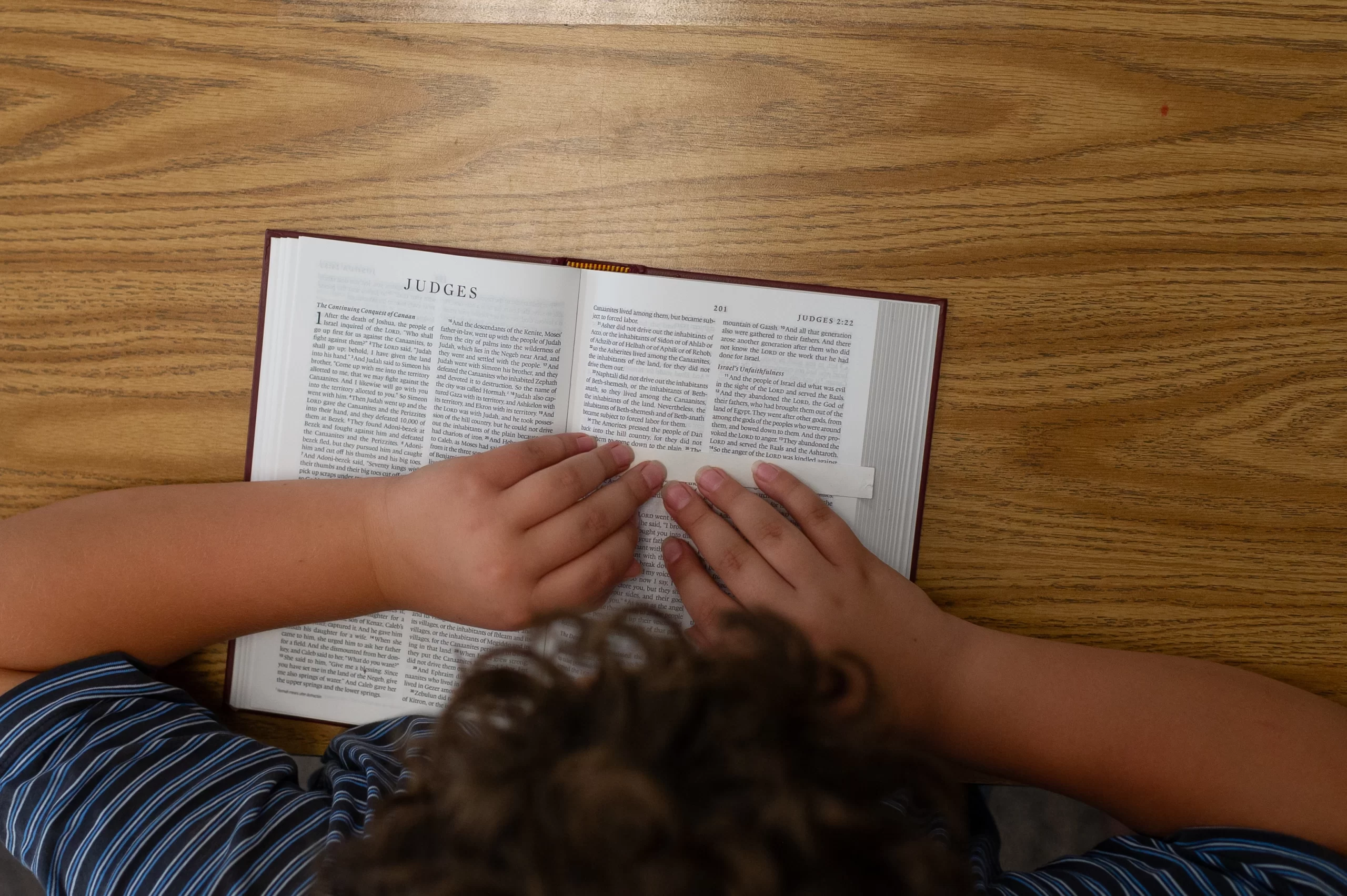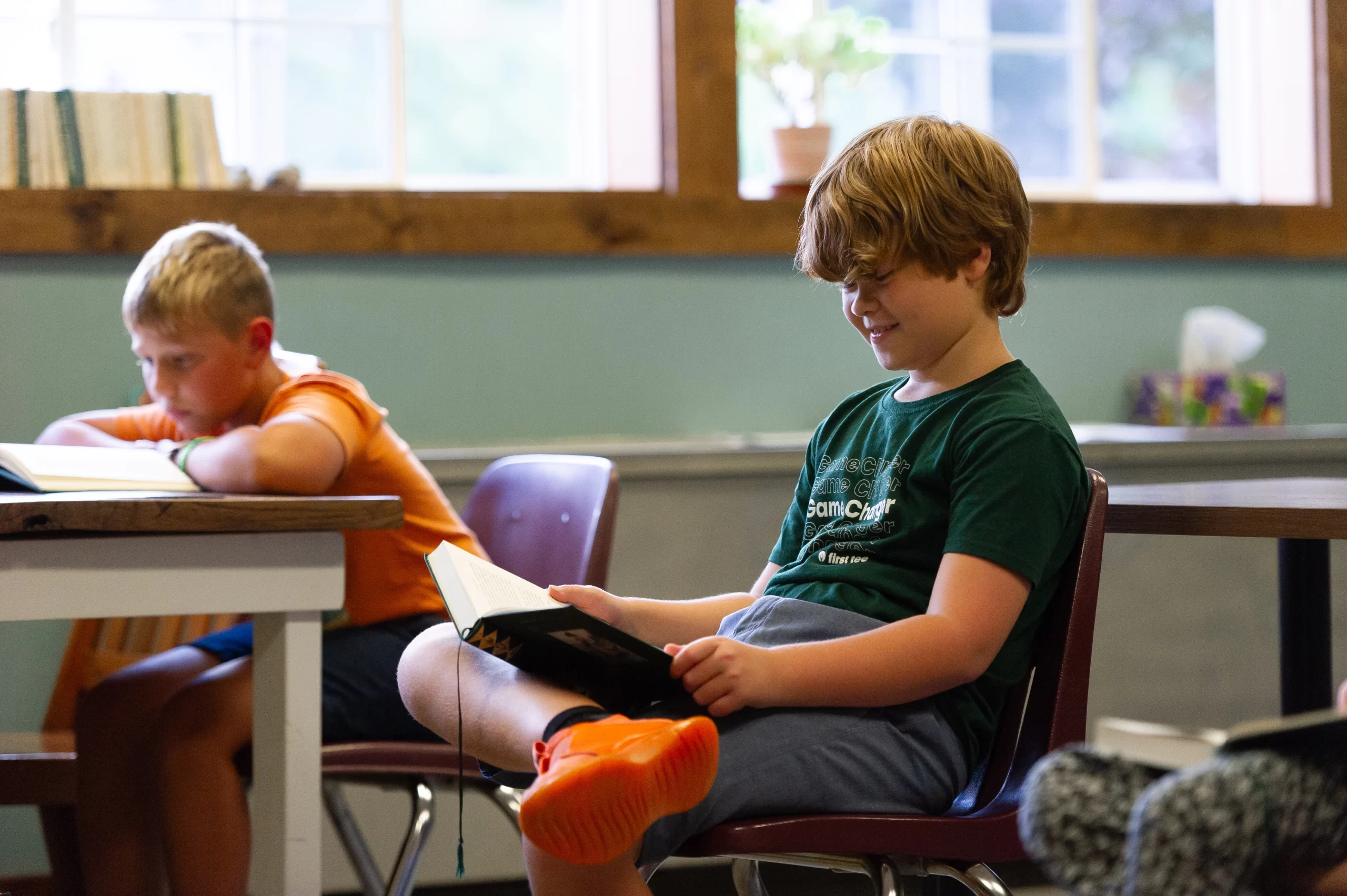Elementary & Middle School Experience
Our students thrive in the midst of living ideas from renowned authors and celebrated classics, learning how to communicate about what they see and hear in their own words. Our junior kindergarten through 8th grade students are trained in 17 different subjects — not limiting interests but providing exposure to a world outside of their own.
The broad foundation for intellectual life and disciplined character established in these students prepares them for the critical thinking skills, growing independence and vocational groundwork that is developed in our Ambleside high school.
Our school atmosphere seeks to free children from the bonds of fear and liberate them to open their minds and hearts to a world rich with relationships, ideas, and beauty.


Junior Kindergarten
The junior kindergarten classroom resembles formal and informal times at home. It offers opportunities for independent and group play, practical life applications, and seasonal art and readings.
Teachers provide formal instruction in Bible, number sense, fine and large motor skills, writing, painting and drawing. Students are guided through times of active play and quiet rest, and the classroom environment provides places for children to sprawl out with blocks and playthings.
Young children are nurtured through relationships with their teacher, learning texts, and interactions with classmates. There are many “firsts” for them, and it is our unique privilege to lead, direct and guide them in healthy relationships with all of life. Teachers introduce text, number, nature, letter, poem, paint and pencil, taking into account that children can flourish as they use these distinct mediums to communicate ideas and expressions in an atmosphere of focused attention, clear instruction, and joy.
Kindergarten
Most people recall kindergarten with fondness. When you see the bright faces of the kindergarten students as they arrive for the first day of school, full of eager anticipation and excitement, it is easy to understand why. In kindergarten, realms of opportunity and knowledge open before children, and the delight and joy they find in this new world is evident each day on their bright faces.
The trajectory of each child’s schooling begins here, and his or her affections toward learning are formed in our classroom. An atmosphere of love, affection, support, safety, learning, growth, well-formed habits, and an appetite for ideas will bless the child for his or her whole life.
Teachers introduce text, number, nature, letter, poem, paint and pencil, taking into account that children can flourish as they use these distinct mediums to communicate ideas and expressions in an atmosphere of focused attention, clear instruction, and joy. Subjects include Bible, literature, mathematics, phonics, reading, spelling, nature study, composer study, and many more.
Class One
First grade is a delightful and enriching year for both teacher and student. Students continue to strengthen their reading, writing, and arithmetic skills. They will delight in Andersen’s fairy tales and the fables of Aesop, laugh with (and at) Pinocchio, celebrate Aslan’s triumph, and perhaps put on a puppet show for their schoolmates … and much more. Students begin to know the created world around them in nature study, a type of science. They also begin to develop fine motor skills and habits of excellence and attention in fine handwork.
Class Two
Second grade strengthens the beginning skills of listening, reading, writing, and arithmetic. They become familiar with the works of Handel and Brahms. Student and teacher will learn to love flowers with Monet, enjoy tales by Beatrix Potter and Laura Ingalls Wilder, and read about William Bradford and Abigail Adams. The courage and selflessness of these Americans, the greed of the Selfish Giant, and the mischief of Peter Rabbit will provoke lively discussion. Students strengthen their hand skills with advanced sewing. These are years of first encounters and new pathways for the mind and brain — what a privilege to play a part in that important formation!
Class Three
Third grade students encounter formal readings in history and science.They discover American history in This Country of Ours and ancient civilizations in On The Shores of the Great Sea, while also exploring mammalogy in science. Their curiosity is piqued by lively, vivid history and literary texts, including Black Beauty and Benjamin West and His Cat Grimalkin.
Their capacity to give attention grows as they learn to observe keenly in science. They begin to learn cursive, write narrations, and build history and science journals. They also become familiar with the works of Hiroshige, Raphael, Vivaldi, and Chopin. Students are ready to learn the worthiness of work and the meaning that comes from working soli Deo gloria (Latin for “glory to God alone”).
Class Four
Fourth grade students are introduced to the idea of citizenship and begin formal instruction in grammar and composition, all while they continue to feast on living ideas. They are introduced to the works of Mozart, Tchaikovsky, Velazquez, O’Keeffe, Sandberg, and Longfellow. They investigate the new world and the American colonies, take up ornithology and meteorology, travel through Spain with I, Juan de Pareja, and explore the Swiss Alps with Heidi.
Conversations in science, history, literature, citizenship, and Bible continue in class discussions. They desire to bring cohesiveness of the past and the present through their questions of how and why.
Fourth grade continues to be a growing-up time, where the children hone in on their skills of relationship with one another. The importance of inclusive relationships is equally on the forefront as children begin to be attracted to others who are “more like me,” whether athletically, intellectually, or in personality. Relationships are optimal when they are inclusive rather than exclusive, and this atmosphere is overseen by the teachers, as they model love and care for others, and quietly and gently provide instruction to do likewise.
Class Five
Fifth grade students solidify elementary skills — gaining fluency in arithmetic, grammar, composition, and geography. They learn to approach work not as data points to be memorized or assignments to be finished, but as opportunities to build subject knowledge, so that they might gain skill and mastery in its use.
They learn to ask, “What do I need to know about grammar so that I can correctly and clearly communicate in speaking and writing all that I know and think? What do I need to know about geography to understand the features of the world, and the relationships of the features on a continent and in parts of the world? Am I fluent with numbers? Can I manipulate whole numbers, fractions, decimals, and percents? Can I use algorithms to describe and solve problems in the physical world?”
Fifth grade students are introduced to the works of Copland, Dvorak, Rembrandt, Turner, Wordsworth, and Frost. They delight in the adventures of Robin Hood, Little Women, and Mr. Bowditch. They practice fine mosaic work, explore the lives of creatures in herpetology, and the formation of rocks and minerals in geology. They turn their attention to the development of modern Europe and its relationship with America and the world.
Class Six
Sixth grade continues to offer a feast of knowledge as students read the lives of Moses to David, the miracles of Jesus, the Sermon on the Mount, and letters to the Church. They learn about the works of Dubussey, Davinci, Whitman, and Tennyson. They’re exploring botany and astronomy in science. They also find inspiration in histories of the British empire and ancient seafarers in the Growth of the British Empire.
They delight in studies of astronomy and botany, the adventures found in Robert Louis Stevenson’s Treasure Island, and a year in the life of a boy in The Yearling. They discover what it means to be a person who is defined by virtue and consistent character as they study Ben Franklin and men and women of the Titanic. This content feeds the minds of teachers and students alike with inspiration and aspiration that permeates heart and mind long after the books are closed.
Students are offered many opportunities to solidify elementary skills that will serve them well throughout their school years. Throughout the year, they build on a foundation of skills and fluency in arithmetic, grammar, composition, and geography. Students continue to approach these subjects not as data to memorize or another assignment to complete, but with the aim of gaining knowledge about the subject, so that they might grow in skill and master its use.
Class Seven
In seventh grade, teachers and students will travel a road together meeting many inspiring souls. These are people, real and fictional, who purposefully pursued joy, hope, peace, and forgiveness in their time, when the evidence before them offered only darkness and despair. They have journeyed before us facing some of life’s greatest challenges and difficulties, from the abolition of slavery to the holocaust.
The texts are so rich that students will almost experience the longing for liberty and justice of Frederick Douglass, the determination and perseverance of Helen Keller, and the isolation and despair of Robinson Crusoe, to name a few. Students follow Solomon to Jeremiah, the parables of Jesus, Paul’s letters, and selections from Psalms and Proverbs.
Students learn the works of Grieg, Bach, Van Gogh, Lawrence, and Langston Hughes. They study entomology and the basics of arduino in science, handwork, and nature studies. For mathematics, students begin pre-algebra.
Class Eight
Eighth grade opens the window to the ideas of the world through the rich text of The Landmark History of the American People; Michigan history; a study of human anatomy in science; music by Gershwin and Mendelssohn; poetry by Hopkins and Coleridge; paintings by Vermeer and Matisse; and a study of Jesus’ sermons, among others. They will laugh at The Scarlet Pimpernel, and wrestle through important ideas in The Hiding Place and Fahrenheit 451. They will also read Charlotte Mason’s books on human formation, Ourselves Books 1–2. Students will begin high school level math with Algebra I.
Students continue to develop skills in composition, algebra, grammar, and transcription, and mature in relating to one another through discussions of living books. As students respond in both discussion and composition, it is important that their work reflects the meaning of the text through reading, assimilating, remembering, and thinking. These skills of reading and writing well, engaging in thoughtful discussion, and asking deliberate questions will serve them well as they prepare for an Ambleside high school.
